
Agave attenuata “Kara’s Stripes” makes its World Debut!
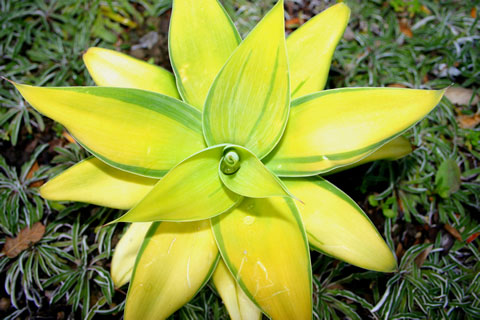
Agave attenuata 'Kara's Stripes' (Variegated Fox Tail Agave) . Young plant in ground grown in full sun, Sunset Zone 15.
A brand new plant to the World as of Summer 2007, ‘Kara’s Stripes’ has been successfully mass produced through the miracle of micropropagation (tissue culture). 'Kara's Stripes' has wonderful broad soft butter-yellow leaves with narrow green marginal stripes. Fear not this plant as it has no spines unlike its prickly cousins. It makes for a handsome potted plant, especially when highlighted with dark foliage plants such as Black Aeonium, Purple Heart, or Black Mondo Grass. Though this cultivar will be slower growing, if planted in the ground it will likely form a clump to 3 to 4 feet or more tall by even wider with many rosettes of pliable leaves that emerge from a tight central spear to arch gracefully back toward the ground. After many years, the plant will form 5 to 10 foot vertical flower stalks that recurve back toward the ground, bearing pale greenish yellow flowers.
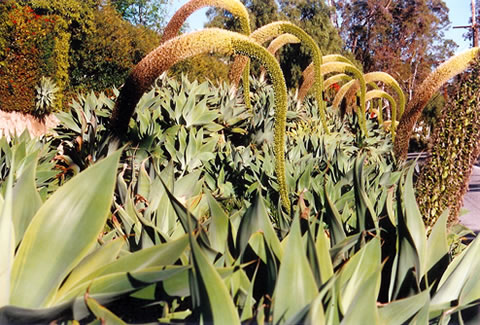
The parent species Agave Attenuata displaying its arching, flowering effect in normal dull green colored leaves, a stark contrast to the brightly colored foliage of Kara’s stripes.
Plant in full sun to shade (brighter light brings out the best color in this variegated plant) in a relatively well drained soil and water occasionally to very little - looks best with regular to some irrigation. Tolerates seaside conditions. The Foxtail Agave will usually be damaged in temperatures below 28° F but mature plants will recover from freezes in the mid to low twenties. Does well indoors in bright light.
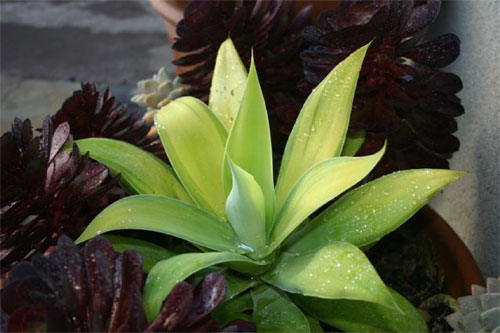
Juvenile Agave attenuata ‘Kara’s Stripes’ container grown surrounded by Black Aeonium.
The Plant that Almost Wasn’t- The Amazing Story of Agave attenuata ‘Kara’s Stripes’
by Gary Gragg
Agave attenuata ‘Kara's Stripes’ was discovered by me, Gary Gragg, in my Martinez garden in 1994. It was a vegetative sport off a common, dull green Agave attenuata. Incredibly excited, I isolated the variegated sport, rooted it and then impatiently grew it for the next 5 years, gradually increasing its numbers through asexual propagation. For those of you who don't know, asexual propagation is reproduction without having sex. That poor loveless Agave. I still feel badly for that plant. By the fall of 1999, I had created about 15 plants. Then it was off to Hawaii for a mid winter vacation. I am always a bit nervous leaving my garden during mid winter for extended periods of time since all my tender plants would be defenseless if it so happened that a damaging freeze were to materialize in my absence. A few days into our 12 day trip, I decided to check the newspaper to see what the late December weather temperatures were like back home. I was stunned to see that San Francisco had a sunny high of 71 degrees, while we had 76 degrees, clouds and rain on Maui. That was an awful long flight for a mere 5 degrees I thought. Well, at least I didn’t need to worry about all my precious plants freezing back home without anyone to protect them. A few days later while sipping a cool drink at the pool bar, I noticed a news flash on the bar’s television that California was suddenly having a major cold snap. I shrugged it off thinking: how bad could it be since it was just in the seventies a few days previous. Turns out, it was pretty bad. I returned to my subtropical garden to see a ton of damage and the unmistakable death stench of rotting plant tissue. Among a long list of other things, I checked on my beloved Agave attenuata ‘Kara's Stripes’ to find them completely melted and rotting. Impatiently waiting until spring, I watched all of them decay to nothing except one; the original mother plant which was much larger than all of the offspring. Yay!!!!! A lone survivor!!!!!
So I went back to the starting line and began the slow methodical process of bulking up on the plant through conventional propagation all over again. By 2005, I had enough plants for patent trials (to see if the plant warranted the patent and naming process.) The few of my remaining plants were sent out to be starter material for tissue culture which promised thousands of plants if the plant was to be conducive to the process. This was a big unkown. Sure enough, tissue culture was successful. Now, 13 years after inception, there exists more than 2000 plants with more on the way which are finding their way into specialty nurseries. FINALLY! DOUBLE YAY!!!!!
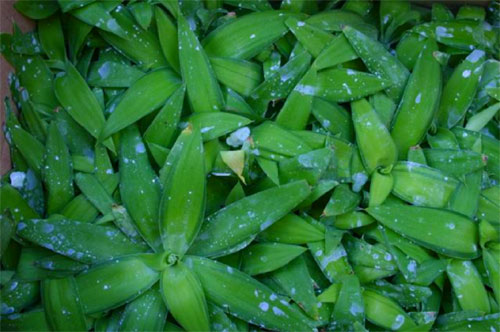
First batch of tissue cultured Agave attenuata ‘Kara’s Stripes’, summer of 2007.
‘Kara’s Stripes’ makes her public debut in March of 2008 at the San Francisco Flower and Garden Show in my exhibit “Jungle Skinny Dip.” She’ll be front and center and proudly naked to the World. Come say hello to her. And after 13 years of tedious development, ‘Kara’s Stripes’ is hitting the streets and will soon be found in many specialty nurseries including of course, Golden Gate Palms.
And on that note, I, the proud father, would like to formally introduce my new baby to the World. It's name is Agave attenuata ‘Kara's Stripes’ and is named after my loving (and very lovely! i. e. HOTTY) wife, Kara. Kara (the hot wife) is characterized by, among other things, beautiful creamy white skin no doubt due to her Norwegian ancestry. ‘Kara's Stripes’ (the plant) differs from the parent species in that the foliage has gorgeous creamy yellow stripes, thus the connection to Kara (the wife).
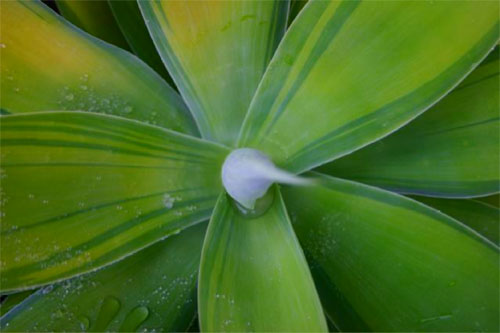
Closeup, Agave attenuata ‘Kara’s Stripes’.
‘Kara’s Stripes’ will achieve its maximum beauty in bright light. Avoid frost, and although agaves in general are drought tolerant, ‘Kara's Stripes’ will grow faster and look sexier if given regular and ample water.
Thanks Hunny Bunny for putting up with all of my wild botanical digressions and mischief. I know it may not seem like it all the time, but I really do love you and the kids more than plants.
